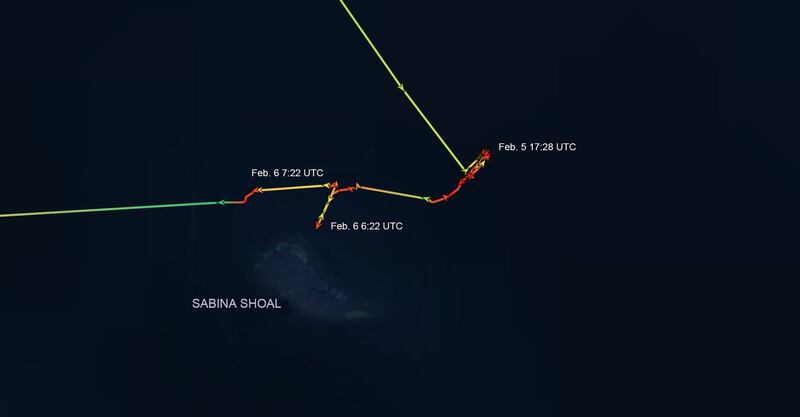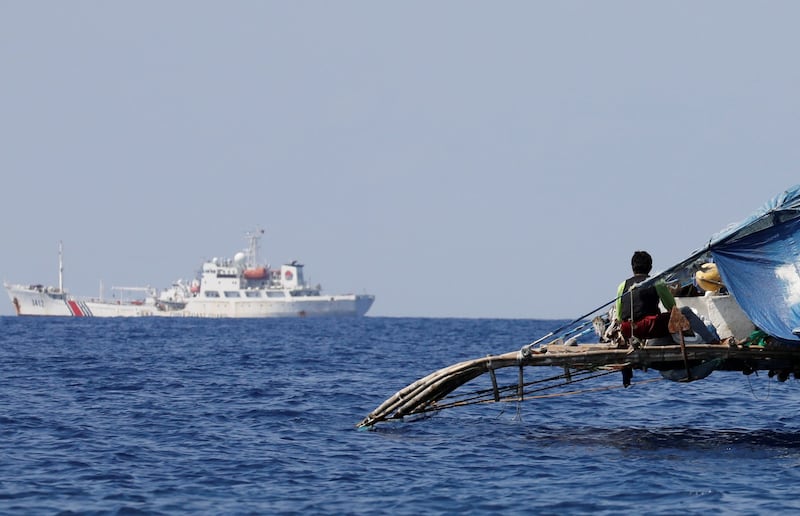The Chinese coast guard was again on Tuesday accused of “tailing and harassing” Philippine law enforcement ships in the South China Sea, possibly due to Manila’s recently announced security agreements with Washington, a maritime security expert said.
China Coast Guard (CCG) ship 5205 “stopped, harassed and followed Philippine Coast Guard BRP Malapascua near Sabina Shoal for more than eight hours on Monday,” alleged Ray Powell, Project Myoushu (South China Sea) lead at Stanford University in California.
Sabina Shoal is a feature located at the so-called Dangerous Grounds in the Spratly Islands, well inside the Philippines’ exclusive economic zone (EEZ) but also claimed by China.
An EEZ gives a state exclusive access to the natural resources in the waters and seabed but those in the South China Sea overlap with the so-called nine-dash line that China uses to claim “historical rights” to most of the sea.
The Philippine Foreign Ministry told BenarNews, an RFA-affiliated online news service, on Tuesday that the incident alleged by Powell “still needs to be verified.”
The same expert last Wednesday told RFA that two CCG ships were monitoring and tailing the movements of the naval patrol vessel BRP Andres Bonifacio near Mischief Reef, also inside the Philippine EEZ.
The Philippine Coast Guard on Saturday confirmed the report to a number of media outlets, including Bloomberg and CNN, but backtracked Monday, saying last week's incident is "unverified."
Regular harassment
In the latest event that took place on Monday, Ray Powell, analyzing automatic identification system (AIS) signals transmitted by vessels, said the CCG 5205 came to a stop right across the BRP Malapascua's path on Sunday evening before “going dark,” or switching off its AIS signals.
The BRP Malapascua then slowed down and “essentially stopped” for hours east of Sabina Shoal.

Data obtained by RFA from the ship tracking website MarineTraffic show the Philippine law enforcement vessel left the area Monday morning without stopping at Sabina Shoal and went west.
Powell told RFA he was “confident” that the CCG 5205 remained in close contact and had a “protracted confrontation” with the Philippine vessel.
While Monday’s incident is yet to be confirmed by Philippine authorities, CCG ships have reportedly stepped up their activities and harassment against Philippine law enforcement vessels in the Philippines EEZ.
Last December, the Chinese coast guard was accused of stopping the warship BRP Andres Bonifacio from approaching Scarborough Shoal, known in the Philippines as Panatag Shoal, which is only 198 kilometers (123 miles) from the strategic Subic Bay but under China’s control.
A U.N. tribunal in 2016 dismissed China’s sweeping claims over most of the South China Sea, including Scarborough Shoal, but Beijing refused to recognize the ruling.

Last November, CCG ship 5203 intercepted a Philippine Navy ship which was towing some wreckage from a Chinese Long March rocket and seized the wreckage.
The following month, CCG vessel 5205 attempted to obstruct a Philippine naval ship that was carrying supplies for troops stationed on the grounded BRP Sierra Madre at the Second Thomas Shoal.
“We may be seeing an uptick in harassment incidents directed at the Philippines specifically, possibly due to the administration’s recently announced security agreements with the U.S.,” said Powell, adding that “Beijing uses a variety of tools to punish and discourage behavior it doesn’t like.”
Joint patrols
U.S. Defense Secretary Lloyd Austin made an official visit to the Philippines last week, during which Manila agreed to grant the U.S. access to a total of nine military bases in the country.
The two sides also agreed to restart a plan to conduct joint patrols in the South China Sea that was shelved under former President Rodrigo Duterte, a move analysts said is much needed amid China’s increasing assertiveness in the disputed waters.
A new study by the Asia Maritime Transparency Initiative (AMTI), a research institution at the Center for Strategic and International Studies in Washington D.C., asserted that CCG ships “maintained near-daily patrols at key features” in the sea, despite that most of them are located in neighboring countries’ EEZs.
CCG vessels have been accused of regularly harassing oil and gas exploration activities by Indonesia, Malaysia and Vietnam.
Six parties hold contesting claims over the resource-rich South China Sea but China’s claims are by far the most expansive.
The Chinese coast guard now has a powerful fleet of around 150 vessels, Kyodo news agency reported recently, quoting sources familiar with the matter.
Around 20 vessels were transferred from the People’s Liberation Army (PLA) Navy, it said.
The Chinese coast guard now has more than twice the 70 large patrol vessels possessed by the Japan Coast Guard, Kyodo said, adding that the Japanese government “has become increasingly alarmed” about the development.
Tokyo and Beijing have been embroiled in a long-standing dispute over the Senkaku Islands, which China calls Diaoyu and are under Japan’s control but also claimed by China.
BenarNews staff in Manila contributed to this report.
BenarNews is an RFA-affiliated news organization.
